I’ll be honest—no guidebook or glossy photo ever prepared me for the moment I first set eyes on the Alhambra. You hear about its palaces and gardens, the intricate tilework and ancient legends. But stepping out onto the hill above Granada, watching the morning sun hit those honey-colored walls, it just feels… different. The air is thick with history, but there’s something else too—a sense that this place remembers every secret it’s ever held.
People say the Alhambra is Spain’s most-visited monument, and I get why. But it never felt crowded in the way I expected. Even with travelers all around, there’s this strange, calm energy—almost as if the place itself insists you slow down and really look. The sound of water trickling in ancient fountains. Cypress shadows moving across a tiled courtyard. That unmistakable smell of sun-warmed stone and blossoming jasmine.
The Alhambra isn’t just another relic from a lost age. It’s a living patchwork of stories—some grand, some tragic, some almost whispered. Sultans walked here, and poets and queens and even a few ghosts, if you believe the tales. And yet, for all its fame, it manages to surprise. I still remember the first time I glimpsed the snow-capped Sierra Nevada through the Hall of the Ambassadors—a reminder that even in a place this old, nature always has the last word.
If you’re anything like me, the Alhambra won’t just tick a box on your travel list. It’ll plant itself in your memory and keep tugging at you long after you’ve left. Let me walk you through what makes it so special—and how you can make the most of your own visit, from the must-see highlights to the little moments that most people miss.

Quick Facts
📍 Location: Granada, Andalusia, Spain
🏗️ Construction Period: 9th century (Fortress), 13th–14th centuries (Nasrid Dynasty origins)
🏰 Architectural Styles: Nasrid/Moorish, Islamic, Renaissance
🎭 Famous For: Ornate palaces, flowing water, lush gardens, panoramic views, legendary stories
👑 Notable Figures: Muhammad I, Yusuf I, Charles V, Washington Irving
🏆 UNESCO Status: Yes (designated in 1984)
🌐 Official Website: alhambra-patronato.es

History & Legends of the Alhambra
If you ask a Granadino about the Alhambra, don’t expect a single answer. Some will say it’s the “red fortress” that watched over the city for centuries. Others see it as a symbol of lost kingdoms, a place where empires changed hands and legends got tangled up with real lives. For me, the Alhambra’s history is a living thing—layered, contradictory, and, somehow, all the more powerful for it.
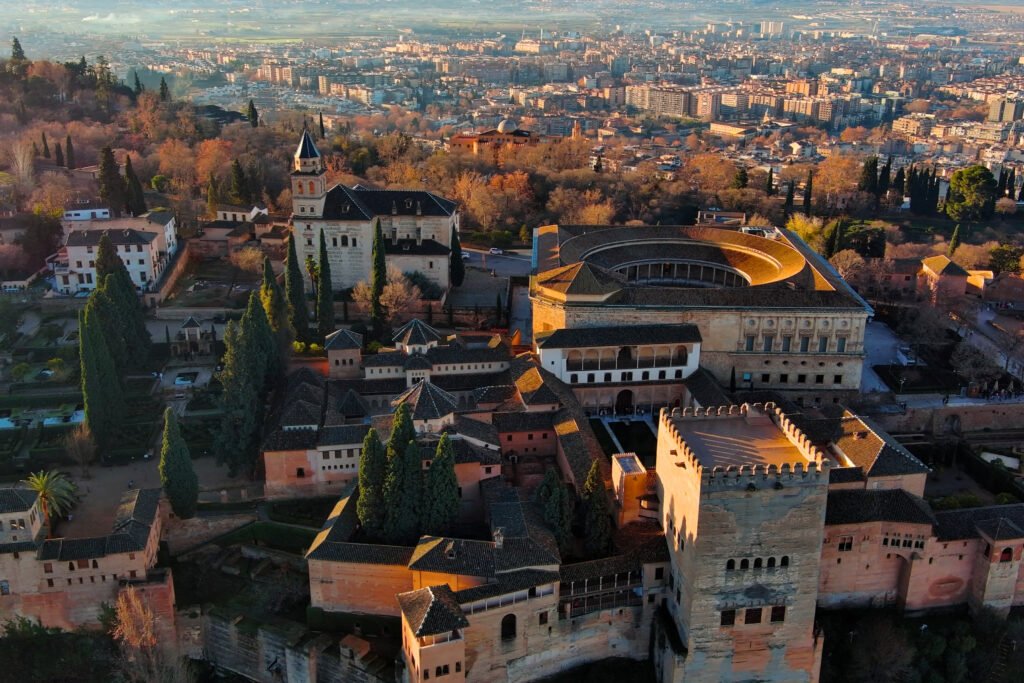
Let’s rewind. The story of the Alhambra doesn’t start with mighty palaces but with a much simpler military outpost. In the 9th century, a small fortress already stood on this strategic hill, though it wouldn’t have turned many heads. Everything changed in the 1200s, when Muhammad I, the founder of the Nasrid dynasty, made this spot the nerve center of his new kingdom of Granada. He saw promise in that dusty ridge above the city and decided to build something that would last.
And last it did. Under the Nasrids—Spain’s last Muslim rulers—the Alhambra grew from a fortified outpost into a royal city, complete with palaces, gardens, baths, mosques, and barracks. Successive sultans each left their mark, but it was rulers like Yusuf I and Muhammad V who gave the Alhambra its signature flair: delicate stucco work, endless calligraphy, intricate wood ceilings, and courtyards designed for shade and reflection. These weren’t just showy luxuries; every detail served a purpose, from the cooling pools to the geometries meant to echo paradise.
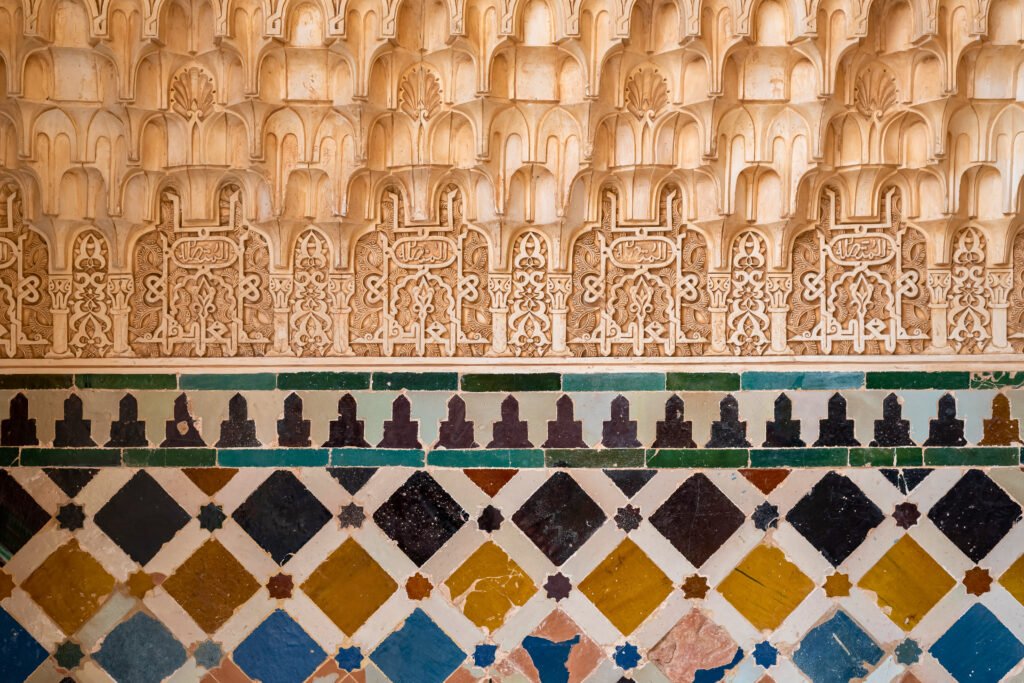
But life at the Alhambra was never just poetry and garden strolls. The sultans ruled during an era of almost constant threat from Christian kingdoms to the north. The Alcazaba—the oldest and most fortress-like part—served as a daily reminder that the city’s safety always hung in the balance. Granada itself was the last holdout of Al-Andalus, the last Muslim-ruled territory in Spain. You can almost sense the anxiety in those defensive towers, the watchfulness carved into the stone.
Then, 1492 happened. Ferdinand and Isabella, the Catholic Monarchs, captured Granada and accepted the last Nasrid sultan’s surrender right here. This is where one of Spain’s most retold legends comes in: as Boabdil (the last sultan) left the Alhambra for the final time, he paused at a mountain pass now called “El Suspiro del Moro”—the Moor’s Sigh. His mother reportedly told him, “Weep as a woman for what you could not defend as a man.” Even if that line sounds a little too dramatic to be true, you can feel the heartbreak in the stone arches and echoing chambers.
Under Christian rule, the Alhambra changed again—sometimes for the better, sometimes not. The monarchs respected much of its beauty, even living here for stretches. But it was Charles V, the Holy Roman Emperor, who made the biggest stamp. He ordered a massive Renaissance palace to be built inside the Alhambra grounds. To this day, the Palace of Charles V stands as a kind of architectural argument with its surroundings—circular, solid, classical, and totally unlike the airy, delicate Nasrid palaces nearby.

As time marched on, the Alhambra slipped into decline. Some rooms became makeshift apartments, storehouses, or even military barracks. The place nearly fell apart—until romantic travelers in the 19th century rediscovered it. Washington Irving, the American writer, famously lived in the Alhambra while working on his Tales of the Alhambra, giving the site a second life in the eyes of the world. Since then, the monument has been protected, restored, and, perhaps most importantly, cherished.
But the Alhambra’s story isn’t all in books or museums. Locals whisper about secret tunnels running beneath the palace, golden treasures still hidden in the walls, or the faint laughter of long-gone royals carried by the wind. On quiet evenings, you might hear the trickle of water and imagine it as the sigh of Boabdil, echoing through time. Whether you’re drawn to drama, beauty, or a sense of mystery, the Alhambra’s history leaves you with more questions than answers. And, honestly, that’s what keeps me coming back.
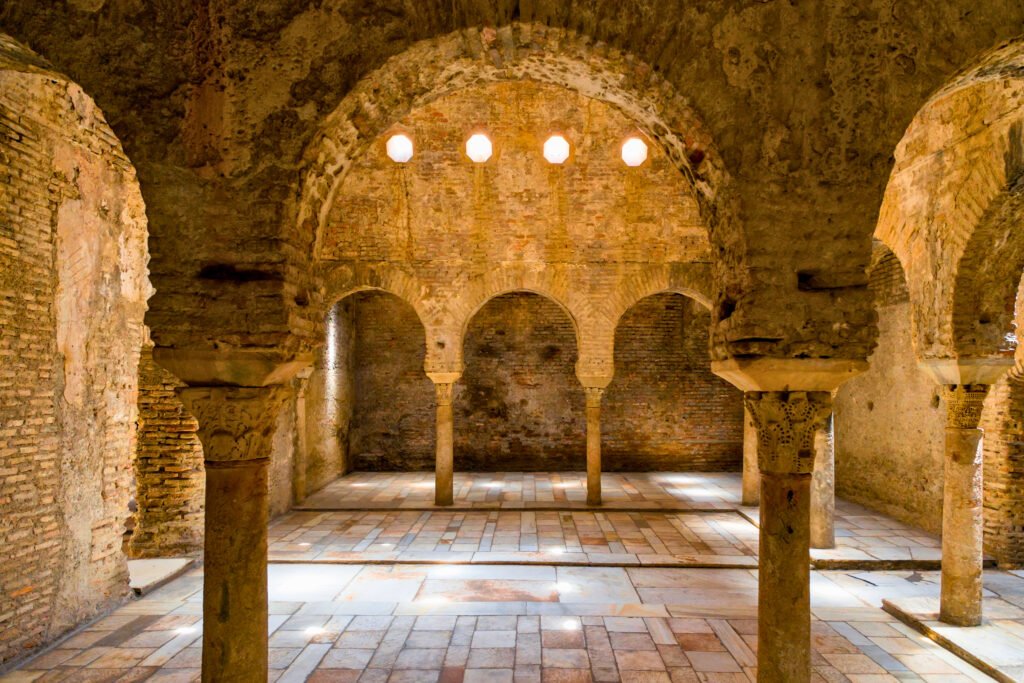

Architecture & Artistic Highlights
Wandering through the Alhambra is a bit like moving through a perfectly orchestrated dream—except the walls, tiles, and columns are all right there under your fingertips. What struck me most wasn’t just the grandeur or the sheer size (though, trust me, it’s bigger than it looks in photos), but the way every space feels intentional. Nothing here is left to chance: the play of sunlight, the hum of water, the smell of orange blossoms—it’s all by design.
The Alhambra is made up of several distinct areas, each with its own vibe. Most people start with the Nasrid Palaces, and for good reason. This is the heart of the complex: a warren of rooms, courtyards, and halls where Granada’s sultans once lived, held court, and plotted their next move. Here, you’ll find some of the most stunning Islamic architecture in Europe. My personal highlight? The Court of the Lions, with its famous marble fountain ringed by twelve carved lions—each one a little different from the next. It’s easy to get caught up photographing details, but pause for a moment and look up: the muqarnas (those honeycomb-like vaults) in the Hall of the Abencerrajes are a master class in geometry and light.

Everywhere you look in the Nasrid Palaces, there’s detail layered on detail. Carved stucco flows across the walls like lace. Bright zellige tiles form repeating patterns that never seem to end. Arabic calligraphy—verses of poetry, blessings, even the sultans’ names—run in looping ribbons above doorways. There’s a line here between ornament and meaning that you don’t often see elsewhere; almost every pattern or phrase points back to the divine or to paradise. I remember touching the cool, patterned tiles and wondering how many hands before mine had done the same.
Next up is the Generalife, the Alhambra’s summer palace and gardens. The name itself hints at luxury—it means “the architect’s garden” or, depending on who you ask, “paradise.” While the palaces get most of the attention, the Generalife’s shaded walkways and lush terraces are just as memorable. The sound of running water is constant here, from the narrow acequias (irrigation channels) to the jets spraying across the Patio de la Acequia. It’s the kind of place where you want to sit and just watch the sunlight filter through the cypress trees. Fun fact: these gardens weren’t just for show—they were practical, too, cooling the air in summer and growing everything from herbs to fruit.
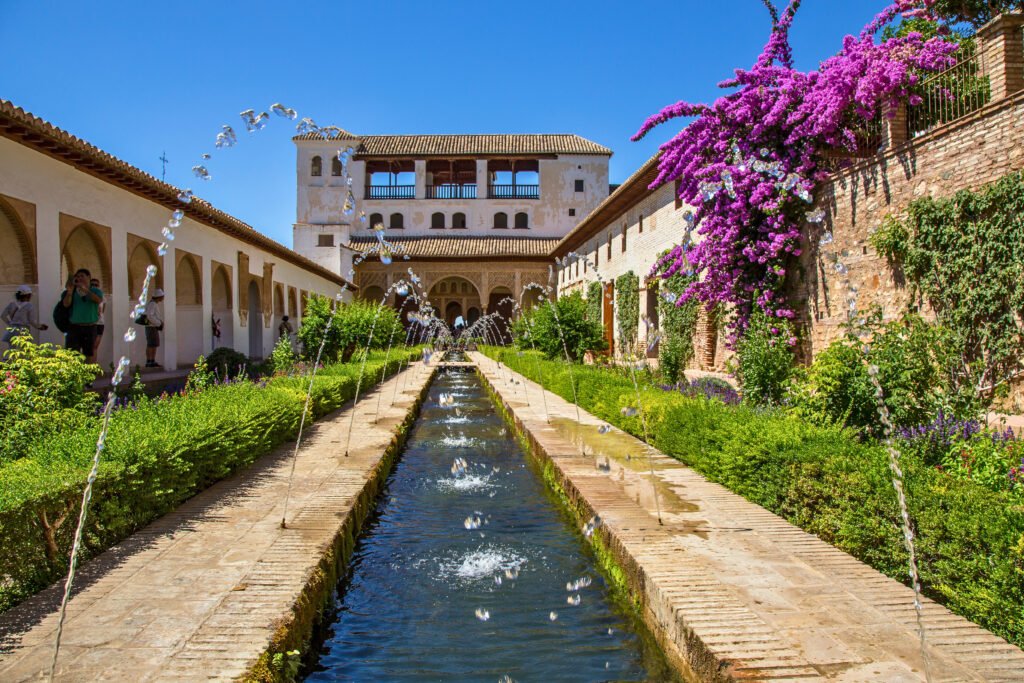
Don’t miss the Alcazaba, the fortress side of the Alhambra. It’s not as decorated as the palaces, but it’s where you get those postcard views over Granada and the Sierra Nevada. Climb up the Torre de la Vela (the Watchtower), especially on a clear morning or at sunset, and you’ll understand why so many rulers wanted to keep this hilltop for themselves.
Then there’s the Palace of Charles V. Some visitors find its Renaissance style jarring—a big, heavy circle plunked down amid all those Moorish arches. But it’s worth a look, especially if you’re interested in architectural contrasts. The massive courtyard and grand staircases are impressive in their own right, and the palace also houses two museums: the Alhambra Museum (for Islamic art and artifacts) and the Fine Arts Museum of Granada.
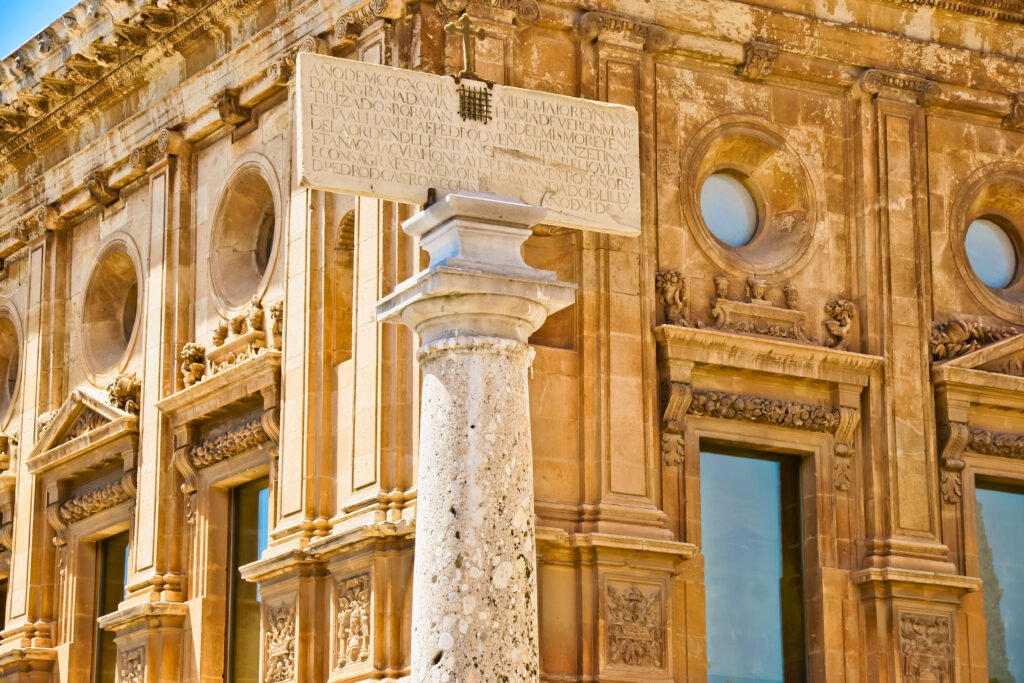
What really sets the Alhambra apart, though, is its use of water and light. Every courtyard is built to catch breezes and reflect pools of sky. Fountains bubble everywhere—not just for decoration, but to create a sense of calm and to cool the air on sweltering Andalusian days. Windows frame views of the city, the mountains, or hidden gardens, making you feel like the landscape itself is part of the design.
Here’s my advice: go slow. Notice the way one room leads quietly into the next, or how the echo of your footsteps bounces between stone and water. The magic of the Alhambra isn’t only in its famous spots—it’s in the small moments of quiet, the details just above eye level, or the patterns of shadow that shift as the day moves on. That’s what will stick with you long after you leave.

Visitor Experience: Practical Guidance for Your Alhambra Visit
Let’s get straight to the details: the Alhambra is amazing, but it’s not a place where you want to just “show up.” A bit of planning goes a long way. Here’s everything I wish I’d known before my first visit—and a few tricks that’ll make your day smoother.

How to Get There
The Alhambra sits on Sabika Hill, overlooking the city of Granada. If you’re coming from the city center, you have options:
- Walking: It’s absolutely possible, and actually kind of lovely if you don’t mind a bit of a climb. Expect a 20-30 minute walk from Plaza Nueva, winding up Cuesta de Gomérez under tall, leafy trees. Take your time and soak in the anticipation—Granada’s old town is charming, and the climb feels less daunting than it looks.
- Bus: Hop on the C30 or C32 minibuses from the city center. They run frequently, and the route drops you near the entrance. Tickets can be bought onboard or with a local card. For most, this is the stress-free option.
- Taxi: If you’re short on time, grab a taxi. It’s a quick, affordable ride up the hill, especially if you’re traveling with others or have mobility issues.
- Driving: Parking is available, but it’s outside the main monument area and can fill up. Unless you have mobility needs, you’re better off leaving the car behind and enjoying the city on foot.
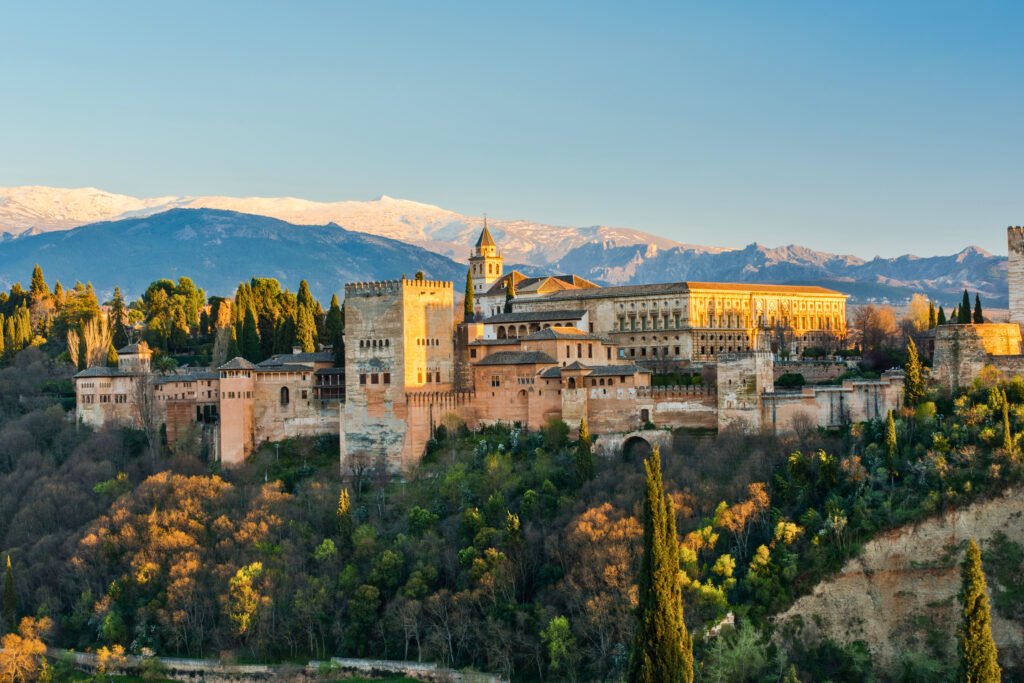
Tickets & Entry
Let’s be honest—this is the part that stresses people out. Alhambra tickets sell out weeks (sometimes months) in advance, especially for the Nasrid Palaces. You must book ahead online through the official website. Avoid third-party resellers unless you want to pay double or risk a scam.
There are different types of tickets, but most travelers choose the “Alhambra General” option, which includes access to the Nasrid Palaces, Generalife, Alcazaba, and Charles V Palace at €19.09. Double-check your ticket: the Nasrid Palaces are only open to you during your specific 30-minute slot, printed right on your ticket. Miss it, and there’s no second chance. Carry your passport or ID, as they sometimes check names at the entrance. Check the official website for the most up-to-date visiting information.
If tickets are sold out, look for guided tours—sometimes, tour companies have their own allocations. As a bonus, a good guide can bring the place to life with stories and insider details you’d otherwise miss.
What to See & Do
- Nasrid Palaces: This is the jewel—don’t miss your time slot. Try to be there 10–15 minutes early, as there’s a separate line and you don’t want to rush.
- Generalife Gardens: Schedule time to wander here either before or after the palaces. The tranquility is real, and it’s often less crowded.
- Alcazaba: Head up the towers for those epic city and mountain views. Morning light is best for photos, but sunset is magic.
- Palace of Charles V: Pop in to see the architecture or explore the museums. Even if it looks out of place, the contrast makes for great conversation.
- Courtyards & Hidden Spots: Don’t just rush between the main sites. Take detours, peek into less-crowded rooms, and pause by the fountains.
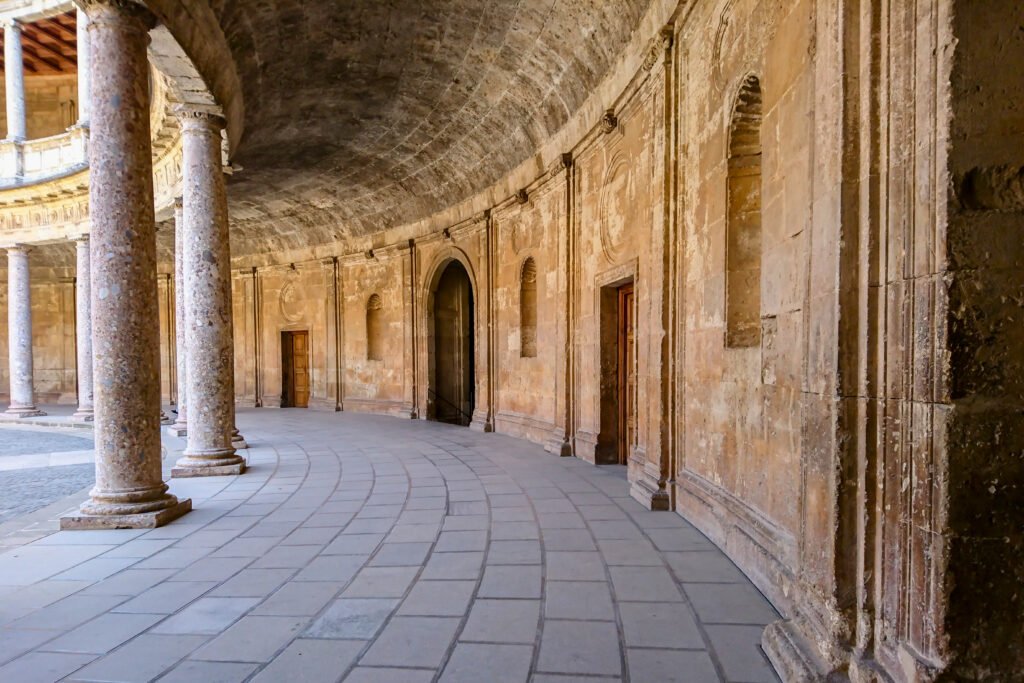
Best Times to Visit
Early morning or late afternoon is best, both for the light and to avoid the bulk of the crowds. In summer, midday can be sweltering—Andalusia isn’t shy about its heat. Spring 🌸 and autumn 🍂 are perfect, with milder temperatures and blooming or golden gardens. Winter has its own charm (and fewer visitors), especially if you catch a glimpse of snow on the Sierra Nevada.
Accessibility & Visitor Tips
- Mobility: Main routes are paved, but some areas have stairs, uneven stone, or slopes. Wheelchair users can access most major parts, though not every historic room.
- Strollers: Allowed in the gardens but not in the Nasrid Palaces. Consider a baby carrier if you have little ones.
- Food & Water: Bring water, especially in warmer months. There’s a café and vending machines near the entrance and Generalife. No food allowed inside the monument itself.
- Restrooms: Well-marked and clean, but spaced out—plan ahead.
- What to Bring: Comfortable shoes, sunscreen, hat, and your ticket/ID. Light layers help, since mornings and evenings can get cool.
- Photos: Allowed almost everywhere, but flash and tripods are a no-go inside the palaces.
A little planning pays off. With the logistics handled, you can just relax and let the Alhambra work its magic.

Local Secrets & Nearby Gems
Even with all the crowds and cameras, the Alhambra still hides a few surprises. The main palaces and gardens are the obvious showstoppers, but if you have a curious streak, you’ll find plenty of quieter corners and special spots—both inside the complex and just beyond its walls.

Hidden Corners in the Alhambra
- Partal Gardens and the Tower Walk: Most people breeze through the Partal Gardens on their way to or from the Nasrid Palaces, but it’s worth slowing down. Sit on a bench by the long reflective pool and look up—the Partal Tower is one of the oldest structures in the complex, and the views out toward the city are some of the best. Nearby, a quiet walkway (the Paseo de las Torres) lets you pass a string of defensive towers, often without the crowds.
- The Lindaraja Mirador: Tucked away off the Hall of the Two Sisters, this little mirador (viewpoint) feels worlds away from the main palace bustle. If you’re lucky, you might get a moment to yourself here, just listening to the trickle of water and the wind in the orange trees.
- Unmarked Fountains and Patios: As you move between the palaces and the Generalife, keep your eyes open for small, often unsigned patios. Some are shaded by giant plane trees or hidden behind unassuming doors—perfect for a breather or an impromptu photo shoot.
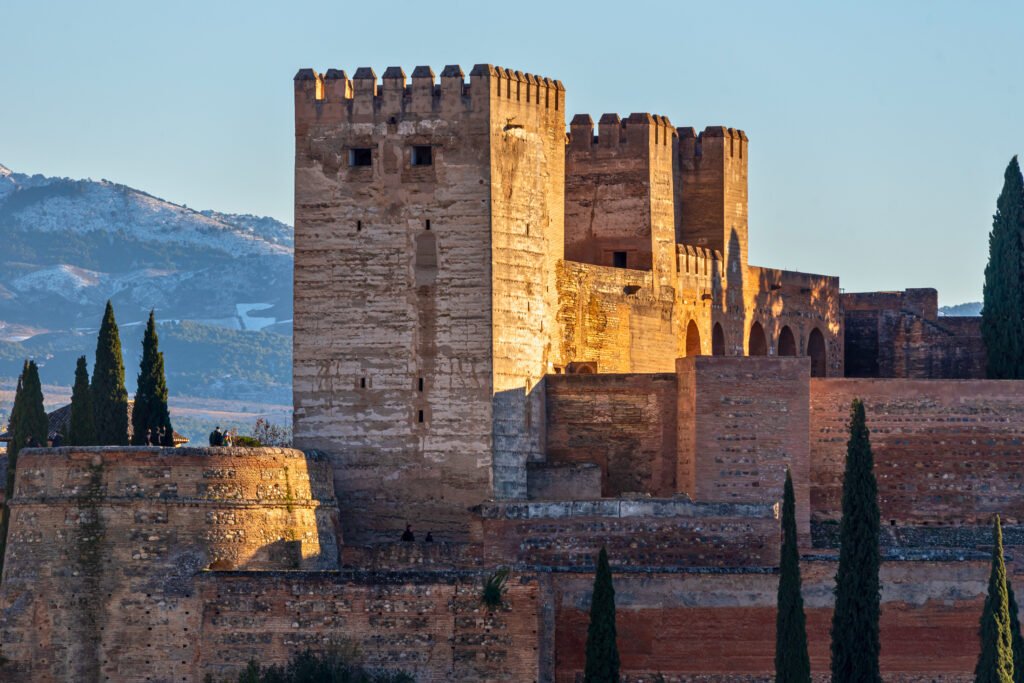
Nearby Attractions Worth Exploring
- Albaicín: Directly across from the Alhambra, this old Moorish quarter is a tangle of narrow streets, whitewashed houses, and hidden squares. Get lost for an hour, stop for tea or a cold drink, and enjoy the old-world atmosphere. Wandering the Albaicín is almost as memorable as the Alhambra itself.
- Mirador de San Nicolás: This viewpoint in the Albaicín draws a crowd every evening for good reason—the sunset view across the gorge to the Alhambra, with the Sierra Nevada behind, is one of Europe’s classics. Go early, claim a spot, and watch as the light turns those red walls to gold.
- Sacromonte: A short walk uphill from the Albaicín, Sacromonte is famous for its cave houses and flamenco shows. It’s a great spot to experience local music and dance in an atmosphere you won’t find anywhere else.
- Corral del Carbón: Back in Granada’s center, this 14th-century building started as an inn and storehouse for traveling merchants. Today, it’s one of the city’s lesser-known Moorish gems—an oasis of peace just steps from the busy streets.
- Carmen de los Mártires: If you’re craving more gardens and want a quieter escape, stroll over to this historic house and its lush grounds. You’ll find peacocks, shaded paths, and lovely views toward both the city and the mountains. Hardly any tourists make it here, which makes it feel like your own secret.

Tapas & Teahouses
Granada is famous for its free tapas culture—order a drink at almost any bar, and a plate of something tasty will follow. My go-to? Head into the Albaicín or near Plaza Nueva for classics like tortilla, jamón, or local cheeses. If you’re after something different, stop by a tetería (teahouse) for mint tea and sweets, surrounded by tiled walls that echo the Alhambra’s style.
It’s tempting to spend your whole day inside the monument, but save time for these neighborhoods. They round out the experience, connecting the Alhambra’s storied past to Granada’s vibrant present. And honestly, some of my favorite memories happened with a cold drink in hand, gazing back at those rose-red walls from a sunlit terrace across the valley.

Suggested Itinerary Ideas
How much time should you set aside for the Alhambra? The answer depends on your pace, your interests, and maybe even the weather. Here’s what I’ve found works best—whether you’re zipping through on a half-day stop or stretching out your visit with time to really soak up the details.
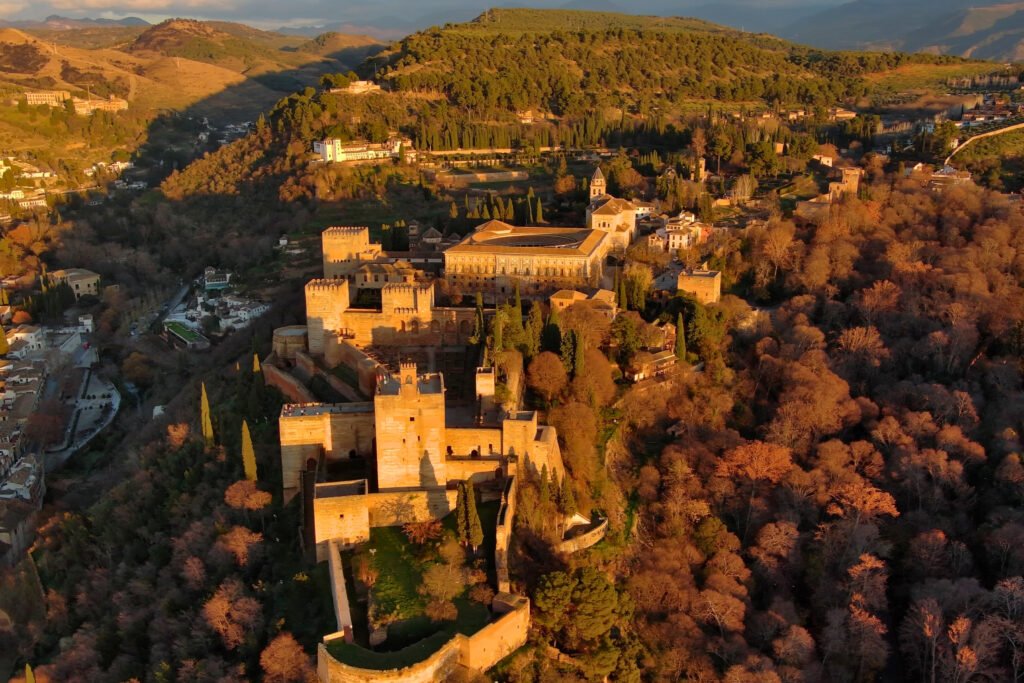
Half-Day Visit (3–4 hours)
- Start Early: Book the first available entry slot if you can. Arrive 30 minutes before your Nasrid Palaces time—this helps you beat the crowds and the heat.
- Nasrid Palaces: Head here first, as your ticket will dictate your entry window. Don’t rush—take your time in the Court of the Lions and the Hall of the Ambassadors.
- Alcazaba: After the palaces, walk over to the Alcazaba. Climb the towers for sweeping city views and a sense of how this place defended Granada for centuries.
- Generalife Gardens: Wrap up with a slow wander through the Generalife. These gardens are peaceful, lush, and usually less crowded later in the morning.
- Coffee Break: There’s a café near the main entrance and vending machines along the way. Refuel and let it all sink in.
Full-Day Experience (6–8 hours)
- Morning: Start as above, but move at a more relaxed pace. After the Nasrid Palaces, explore the Partal and the Tower Walk—these are often quiet and full of details people miss.
- Midday: Pause for lunch. Either try the Parador restaurant (inside the monument) or bring a snack to enjoy in the shade near the Generalife exit.
- Afternoon: Return to the Palace of Charles V. Visit the Alhambra Museum and Fine Arts Museum if you like art and history.
- Gardens & Hidden Corners: Spend extra time in the gardens or seek out those lesser-known patios and miradors. If you’re a photographer, the light gets softer and more dramatic as the afternoon moves on.
- Evening: If you booked a night visit (yes, this is an option for the Nasrid Palaces and Generalife on certain days), prepare for a completely different vibe—quieter, more mysterious, with subtle lighting on the tilework.
Add-Ons for Multi-Day Stays
- Alhambra by Night: The Nasrid Palaces and Generalife offer limited night visits—smaller groups, dramatic lighting, and a much calmer atmosphere. If you’re staying overnight in Granada, it’s worth booking both a daytime and an evening slot for contrast.
- Walks to Miradors: Between visits, stroll over to the Mirador de San Nicolás or the Carmen de los Mártires gardens for more photos and a change of scenery.
- Explore Surroundings: Dedicate a half-day to wandering the Albaicín or catching a flamenco show in Sacromonte. The Alhambra is the star, but Granada’s neighborhoods are the supporting cast.
Tips for All Itineraries
- Rest and Refuel: The Alhambra is big, and you’ll be on your feet most of the day. Don’t skip water breaks and little pauses to enjoy the gardens or views.
- Leave Room for Serendipity: Some of the best moments happen when you stray off the main route or linger in a quiet corner. Let your curiosity guide you.
If you plan well, you’ll have time for both the famous highlights and the smaller, soul-stirring moments that make the Alhambra unforgettable.

Frequently Asked Questions (FAQ)
How far in advance should I book my Alhambra tickets?
Ideally, book at least one to two months ahead, especially during peak spring, summer, and holiday periods. Tickets for the Nasrid Palaces are limited and go quickly.
Can I visit the Alhambra without a ticket?
Some areas outside the main monument, like parts of the forested grounds or the Palace of Charles V’s exterior, are open to all. But to see the Nasrid Palaces, Alcazaba, Generalife, and most gardens, you’ll need a ticket.
What happens if I miss my Nasrid Palaces entry time?
Unfortunately, entry to the Nasrid Palaces is strictly timed. If you miss your slot, you won’t be allowed in, and staff rarely make exceptions. Set a reminder and arrive early!
Are guided tours worth it?
If you love context, yes. A knowledgeable guide brings the site to life with stories, historical tidbits, and access tips you’d never find in a guidebook. Some tours include special routes or after-hours access.
Is the Alhambra accessible for visitors with mobility issues?
Most main areas are accessible, but there are uneven paths, cobblestones, and stairs in some historic sections. Wheelchair routes are well marked, and staff are generally helpful—just mention your needs at the entrance.
Can I bring a stroller?
Strollers are allowed in the gardens and outside areas but not inside the Nasrid Palaces. Consider a baby carrier for small children.
Are there places to eat inside the Alhambra?
Yes—there’s a café near the main entrance and a restaurant at the Parador hotel. Snack machines are also dotted around, but picnic-style eating isn’t allowed inside the monument.
Is photography allowed?
You can take photos almost everywhere, but flash and tripods are prohibited inside the Nasrid Palaces. Respect signs—some rooms occasionally restrict photography during special exhibits.
What should I wear?
Comfortable shoes are a must; you’ll be walking and standing a lot, sometimes on uneven stone. Layers are helpful—mornings and evenings can be cool, even in summer. Dress respectfully; the site has religious and historical significance.
Can I visit the Alhambra at night?
Yes! On select evenings, special tickets are available for night visits to the Nasrid Palaces or the Generalife. It’s a magical experience—quieter and dramatically lit, offering a very different mood from the daytime crowds.
Is it worth visiting if it’s raining or in winter?
Absolutely. The crowds thin out, the gardens are still beautiful, and the interior rooms are just as impressive. Bring an umbrella and enjoy the quieter atmosphere.

Final Thoughts
Honestly, every time someone brings up the Alhambra, I feel a weird mix of nostalgia and jealousy. I wish I could go back and see it again for the first time. My shoes were dusty by noon, my camera battery died early, and I barely scratched the surface of what I wanted to see. But it’s the ordinary stuff I remember: nearly tripping over a step because I was too busy gawking at the ceilings, getting lost between the palaces, or eavesdropping on a group of Spanish schoolkids who were convinced the place was haunted.
If you’ve read this far, you’re probably a castle nut like me—or you just want a travel experience that isn’t easy to describe in a single sentence. I say go for it. Skip the checklist mentality. Bring a snack, wear shoes you can actually walk in, and let yourself wander. There’s no “right” way to see the Alhambra. If you end up spending most of your time sitting in a shady spot just people-watching, that counts.
And if you’ve already been, you know what I mean. Did you find a favorite corner? Get stuck in a crowd and end up somewhere unexpected? Send your best story—or your biggest fail—in the comments 💬. Or tag us in a photo if you’re on Instagram (@CastleQuestChronicles). That’s half the fun.
Still mapping out your trip? Check out my rambling on Granada’s Albaicín or some of the other wild castles I’ve stumbled across in Spain. I’m always hunting for new ideas, too.
Whatever you do, don’t overthink it. Just go. The Alhambra’s the kind of place you’ll keep replaying in your head long after you’ve left.
👉 Love castles as much as we do? Check out our guides on Edinburgh Castle and Neuschwanstein Castle next.
📸 And if this article sparked your curiosity about the castles, follow along. We are on Instagram, Pinterest, Facebook, and X, too. More castles (and more stories) are just around the bend. Explore all our castle adventures here!

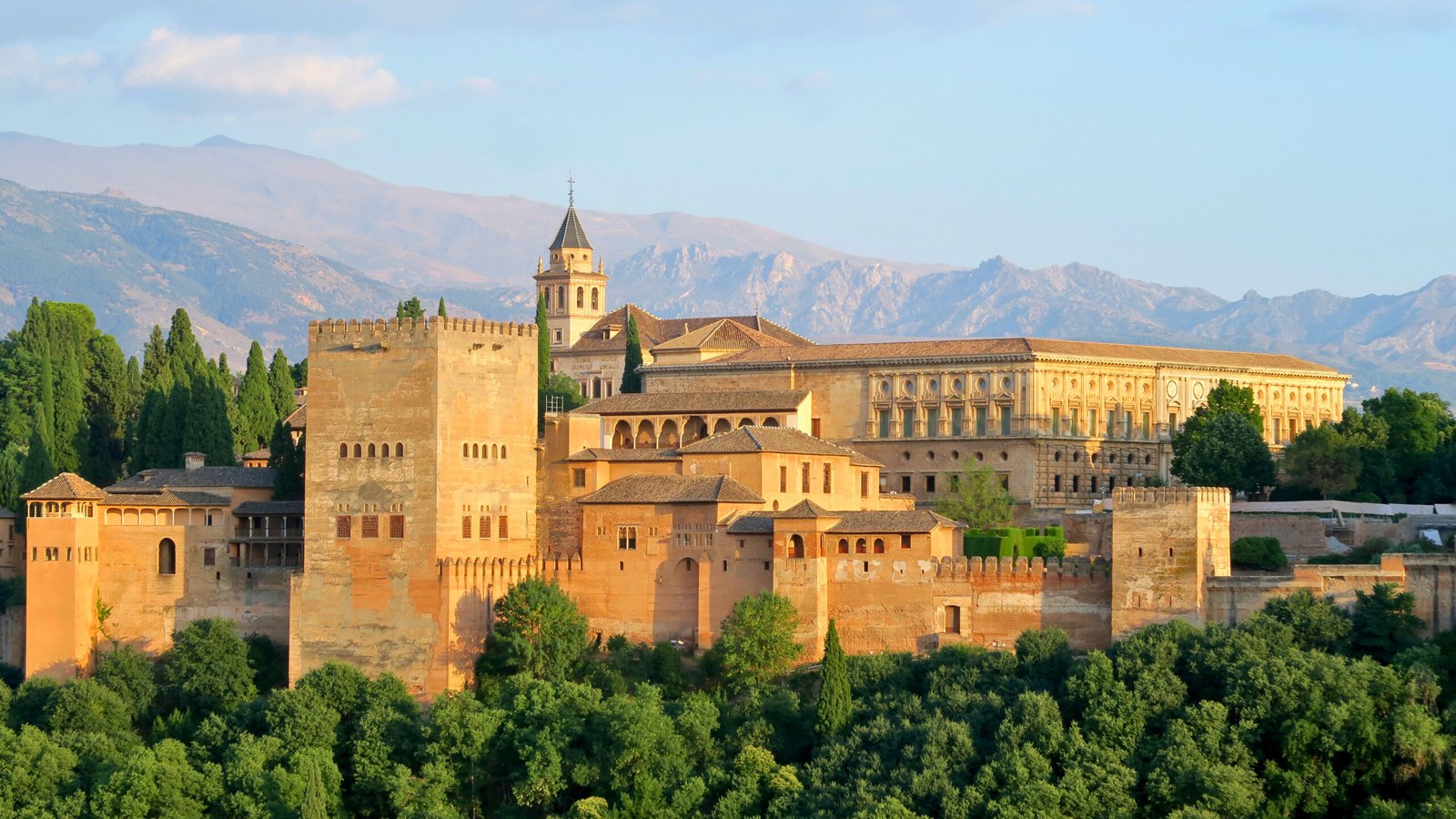





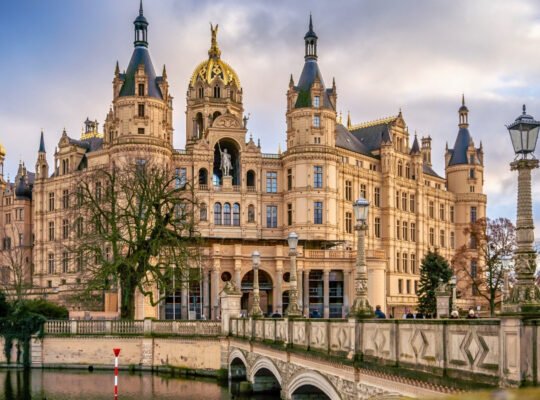

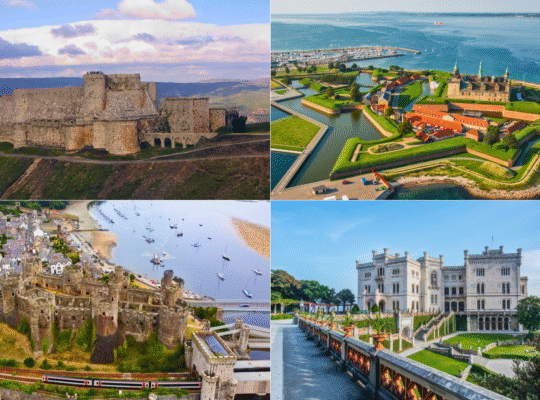


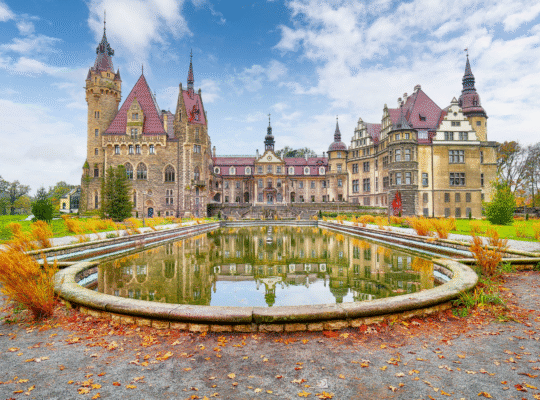
1 Comment